Self-Contained Water Coolers: Xigmatek AIO vs. Evercool Silver Knight
by Wesley Fink on July 10, 2007 2:00 AM EST- Posted in
- Cases/Cooling/PSUs
Xigmatek AIO
Xigmatek Co., Ltd. is a new name in thermal products, It is a Taiwan company affiliated with the Xinruilian Science & Technology Co. Ltd., located out of China. This company is one of the largest fan and PC power supply makers in the world and produces the well-known X-Fan line of PC system fans. There are six founders and one major investor in Xigmatek - all of whom have many years of direct experience in the PC cooler industry. More information about Xigmatek and the company's product line is available at the Xigmatek website.
Xigmatek is currently entering the US market, which is why the products will likely be unfamiliar to US readers. However, the company currently distributes products through primary distributors in Germany and Japan, and the products are available throughout Asia. While final pricing of the AIO will be set by the US distributor, MSRP is $69.95 with a likely street price of the Xigmatek AIO of around $60.
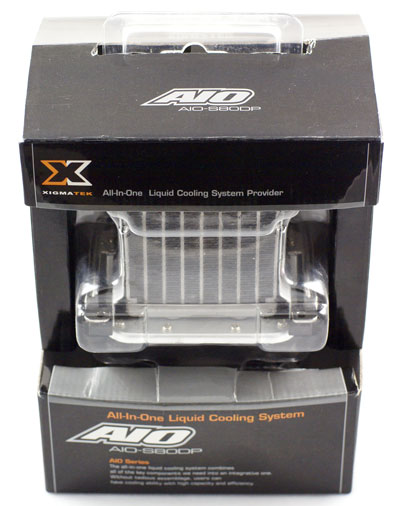
As the Xigmatek package proclaims, this self-contained water cooler is the AIO, or All-In-One, with an official model number of the AIO-S800P. The 800 in this case likely refers to the 80mm fan used in the design, and the P perhaps refers to "parallel" since the Xigmatek uses a pair of radiators for liquid cooling.
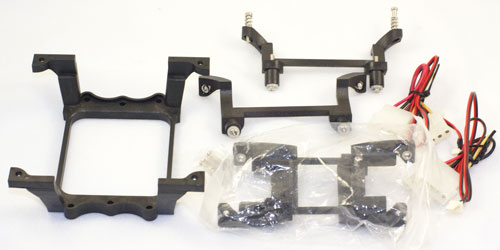
Inside the box is a ready-to-mount AIO, the mounting accessories for mounting the AIO on an Intel socket 775 or socket 478, and the mounts for AMD socket 754/939/940 and AM2. Xigmatek also includes an installation guide, two power converters for the fan headers to Molex connectors, and a packet of thermal grease. Everything in the package is protected by an inner plastic clamshell. Our sample was well-protected during shipping and had no visible damage when we unpacked the cooler.
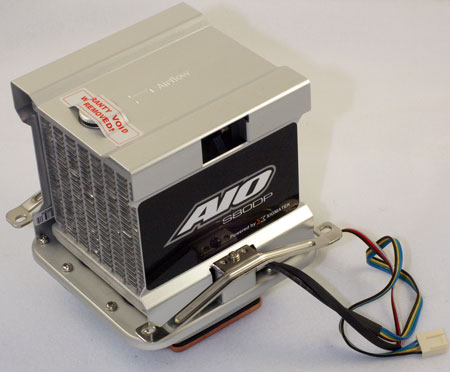
If the Xigmatek looks to you like an old-time car radiator, there is a reason for that. Xigmatek has combined a bottom reservoir, just above the copper mounting plate, with a super quiet 12V pump in the reservoir area. This delivers liquid to the two radiators - one on each end of the tower - with an 80mm fan sandwiched in-between for cooling. Unique to the Xigmatek design is that no water pipes are used and water continues to cirulate even when the system is off. Xigmatel claims this design provides the least resistance to the flow of water into the radiator, which delivers an impressive 72 L/hr flow from a small 80mm design.
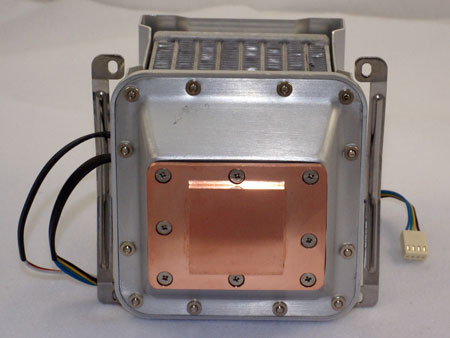
There are two fan connectors. One is a standard 3-pin for the water pump. If you are more comfortable this connector can be driven by an included Molex connector - useful for boards with anemic fan header wattage. There is also a standard Intel 4-pin fan connector for the variable fan speed, and an included adapter to Molex for those who prefer that route. We connected the 4-pin to the Intel header and the 3-pin to the Molex adapter for safety and experienced no problems during our testing.
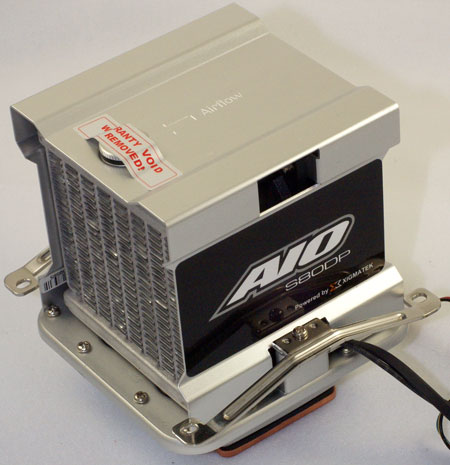
Air-flow direction is indicated by an arrow on the top of the cooler, and the arrow should generally be pointed toward the back of the case, an exhaust vent, or a case fan. You can also see the cap for refilling the water system if needed. It is covered with "Warranty Void" tape, however, to reflect the fact that Xigmatek specifies a useful life of 30,000 hours before any refilling or topping off of the liquid is required.
Mounting is simple and reasonably secure with either 775 or AMD. The cooler mounts to a mounting cage (AMD) or adapters (775) that are screwed to the motherboard. The cooler rests on the mounting cage and is secured by four spring-loaded screws. You will need to remove the motherboard for mounting the AIO, but it is otherwise a fairly painless install.
The AMD/AM2 install is the more secure since it uses a complete rigid cage for mounting the cooler. The Intel install uses half-adapters molded from rigid plastic. The adapters seem rigid enough, but the half-adapter design allows a fair amount of flexing on the socket 775 motherboard used to test the Xigmatek AIO. The complete cage used for the AMD/AM2 install appears to provide better support for the 840g self-contained water cooling system.
Our sincere thanks to Frozen CPU and Xigmatek for arranging a retail review sample of the AIO.
Specifications
Our test system is Intel socket 775, but the AIO will mount on any recent AMD socket as well - including 754/939/940 and AM2. The Xigmatek kit includes the cage and spring-loaded screws for AMD processors. All the needed hardware is included, and installation is very easy on AMD/AM2 sockets once the motherboard is removed from the case.
The Xigmatek is relatively small compared to heatpipe towers. This is mostly because it is based on an 80mm fan and 80mm radiators. At 127mm high it should fit in most cases. You will need to check on the clearances for HTPC cases. The test bed EVGA 680i is a difficult to fit board due to the copper-finned heatsink and fan cooling the Northbridge. The AIO fit comfortably on the 680i. Installation was also an easy task on the ASUS Striker and ASUS Commando, and on the two new P35 ASUS boards - the P5K Deluxe and P5K3 Deluxe. The P5K3 Deluxe is another "difficult-fit" board since the heatpipes completely circle the CPU socket and connect various cooling heatsinks around the CPU socket.
Xigmatek Co., Ltd. is a new name in thermal products, It is a Taiwan company affiliated with the Xinruilian Science & Technology Co. Ltd., located out of China. This company is one of the largest fan and PC power supply makers in the world and produces the well-known X-Fan line of PC system fans. There are six founders and one major investor in Xigmatek - all of whom have many years of direct experience in the PC cooler industry. More information about Xigmatek and the company's product line is available at the Xigmatek website.
Xigmatek is currently entering the US market, which is why the products will likely be unfamiliar to US readers. However, the company currently distributes products through primary distributors in Germany and Japan, and the products are available throughout Asia. While final pricing of the AIO will be set by the US distributor, MSRP is $69.95 with a likely street price of the Xigmatek AIO of around $60.

As the Xigmatek package proclaims, this self-contained water cooler is the AIO, or All-In-One, with an official model number of the AIO-S800P. The 800 in this case likely refers to the 80mm fan used in the design, and the P perhaps refers to "parallel" since the Xigmatek uses a pair of radiators for liquid cooling.

Inside the box is a ready-to-mount AIO, the mounting accessories for mounting the AIO on an Intel socket 775 or socket 478, and the mounts for AMD socket 754/939/940 and AM2. Xigmatek also includes an installation guide, two power converters for the fan headers to Molex connectors, and a packet of thermal grease. Everything in the package is protected by an inner plastic clamshell. Our sample was well-protected during shipping and had no visible damage when we unpacked the cooler.

If the Xigmatek looks to you like an old-time car radiator, there is a reason for that. Xigmatek has combined a bottom reservoir, just above the copper mounting plate, with a super quiet 12V pump in the reservoir area. This delivers liquid to the two radiators - one on each end of the tower - with an 80mm fan sandwiched in-between for cooling. Unique to the Xigmatek design is that no water pipes are used and water continues to cirulate even when the system is off. Xigmatel claims this design provides the least resistance to the flow of water into the radiator, which delivers an impressive 72 L/hr flow from a small 80mm design.

There are two fan connectors. One is a standard 3-pin for the water pump. If you are more comfortable this connector can be driven by an included Molex connector - useful for boards with anemic fan header wattage. There is also a standard Intel 4-pin fan connector for the variable fan speed, and an included adapter to Molex for those who prefer that route. We connected the 4-pin to the Intel header and the 3-pin to the Molex adapter for safety and experienced no problems during our testing.

Air-flow direction is indicated by an arrow on the top of the cooler, and the arrow should generally be pointed toward the back of the case, an exhaust vent, or a case fan. You can also see the cap for refilling the water system if needed. It is covered with "Warranty Void" tape, however, to reflect the fact that Xigmatek specifies a useful life of 30,000 hours before any refilling or topping off of the liquid is required.
Mounting is simple and reasonably secure with either 775 or AMD. The cooler mounts to a mounting cage (AMD) or adapters (775) that are screwed to the motherboard. The cooler rests on the mounting cage and is secured by four spring-loaded screws. You will need to remove the motherboard for mounting the AIO, but it is otherwise a fairly painless install.
The AMD/AM2 install is the more secure since it uses a complete rigid cage for mounting the cooler. The Intel install uses half-adapters molded from rigid plastic. The adapters seem rigid enough, but the half-adapter design allows a fair amount of flexing on the socket 775 motherboard used to test the Xigmatek AIO. The complete cage used for the AMD/AM2 install appears to provide better support for the 840g self-contained water cooling system.
Our sincere thanks to Frozen CPU and Xigmatek for arranging a retail review sample of the AIO.
Specifications
Our test system is Intel socket 775, but the AIO will mount on any recent AMD socket as well - including 754/939/940 and AM2. The Xigmatek kit includes the cage and spring-loaded screws for AMD processors. All the needed hardware is included, and installation is very easy on AMD/AM2 sockets once the motherboard is removed from the case.
| Xigmatek AIO Specifications | ||||
| Heatsink | ||||
| Dimensions | 114(W) X 121(D) X 127(H)mm | |||
| Weight | 840g | |||
| Material | Copper Base and dual corrugated Aluminum Fin radiators | |||
| Water Block | Copper 70x54x14 | |||
| Radiators | Two Aluminum 80x88.7x22mm | |||
| Water System | Refillable, should not require refilling for at least 30,000 hours | |||
| Rated Voltage | DC 12V | |||
| Pump | ||||
| Voltage/Input Current | 12V/0.3A | |||
| Speed | 3500rpm | |||
| Water Flow | 72 L/hr | |||
| Bearing Type | Ceramic Shaft | |||
| Life Expectancy | 50,000 hours | |||
| Noise Level | 19dBA | |||
| Fan | ||||
| Fan Size | 80x80x25mm | |||
| Bearing Type | Ball Bearing | |||
| Fan Life | 50,000 hours | |||
| Connector | 4-pin (Intel 4-pin, PWM Ready) Variable Speed | |||
| Thermal Resistance | 0.21-0.35C/W | |||
| Speed | Lo Speed | 1,800rpm | Hi Speed | 3,500rpm |
| Noise Level | Lo Speed | 20dBA | Hi Speed | 32dBA |
| Fan Output | Lo Speed | 27.88cfm | Hi Speed | 52.72cfm |
| Air Pressure | Lo Speed | 1.84mmH2O | Hi Speed | 5.56mmH2O |
The Xigmatek is relatively small compared to heatpipe towers. This is mostly because it is based on an 80mm fan and 80mm radiators. At 127mm high it should fit in most cases. You will need to check on the clearances for HTPC cases. The test bed EVGA 680i is a difficult to fit board due to the copper-finned heatsink and fan cooling the Northbridge. The AIO fit comfortably on the 680i. Installation was also an easy task on the ASUS Striker and ASUS Commando, and on the two new P35 ASUS boards - the P5K Deluxe and P5K3 Deluxe. The P5K3 Deluxe is another "difficult-fit" board since the heatpipes completely circle the CPU socket and connect various cooling heatsinks around the CPU socket.










26 Comments
View All Comments
mikelimtw - Thursday, July 12, 2007 - link
First off, I would like to thank everyone who has taken the time to weigh in on the product, be it positive or negative. We take user comments seriously because we care about what our customers or potential customers think.I started reading this site when it first came online and have been a regular reader since. However, I also know that people like ourselves make up the top 10 percent of PC users who really know all the ins and outs of PC hardware. As such, it is also sometimes too easy for us to become jaded about products such as our AIO-S80DP cooler; especially when they don't meet our very high standards.
I will admit that this product won't necessarily appeal to the hardcore user because it does not possess the highest performance. However, I would like to present another point of view for your consideration; that is, the point of view from most average PC users who do not possess the skills or knowledge that many of us take for granted.
Xigmatek had a few considerations when creating this product:
1) Ease of use
2) Safety
3) Performance
4) Noise
5) Weight
Ease of Use:
We realized that traditional water cooling isn't meant for everyone despite the performance of such systems. I've read more than enough horror stories about inexperienced users putting together a water cooling system only to accidentally fry their PCs due to leaks.
The Xigmatek AIO-S80DP was designed to be easy to use and to bring the benefits of water cooling to the masses. The design integrates the best features of traditional air coolers and water cooling systems while providing reasonable performance. It mounts like a traditional air cooler but provides the near silent operation advantage of water coolers. Additionally, you can use our product for 2 years without the need for a refill - try that with a traditional water cooling system.
Safety:
Unlike traditional water cooling systems where you are required to cut tubing, connect tubing to water blocks, pressure test for leaks, etc. etc., the all-in-one design assures that there are no leaks when using this product. This built in safety factor is what allows us to expand the user base. We can now include people who like the advantages of water cooling, but don't have the technical savvy to pull off assembling such a system.
Another added safety feature comes from the unique design and integration of the radiators to the resevoir. There is no tubing inside the radiators because they cut down the flow of water. We have implemented a unique free flow system that allows a massive 72 liters per hour of water circulation. The water continues to passive circulate in the cooler after the system (and therefore the pump) is shut down. This helps to continue to quickly cool your CPU thus extending its service life. This is also the reason why our 80mm design handily beats Evercool's 92mm unit in most performance metrics.
Performance:
Again, it was shown in the review that this product was not the top performer. However, as noted by another user, it is well within the top 10 performers out of the extensive list of coolers tested. It's true that we gave up some performance to the top air coolers - but not much. The difference was just over 100MHz of core clock speed. I consider this a reasonable tradeoff for providing the ease of use and safety factors associated with this design - keeping in mind that hardcore users may not be the main target audience for this product.
Noise:
This is a traditional strength of water cooling systems. While many of you may not mind the fan noise generated by top performing air coolers, I'd have to play Devil's Advocate and ask why water cooling systems exist in the first place. Water cooling exists not just for the performance but also for the silence. I think most PC users would prefer a quiet PC. Otherwise there's also no reason for ever larger air coolers using 120mm fans.
While our AIO product is not silent it is reasonably quiet, despite the fact that is is based on an 80mm design. Again, this was a compromise for weight, size and pump noise. Overall, however, I think we did a good job on the noise side, and Wesley seems to agree.
Weight:
Nowadays, air coolers that are approaching 1Kg in weight are pretty commonplace, especially among the top air coolers which use a pure brute force approach to solving the thermal dilemma. By this I mean they use lots of large fins for surface area, lots of long copper heat-pipes and large fan units.
However, many people either don't care or don't realize the mechanical stresses placed on motherboards with such heavy coolers hanging off of them. The 80mm design was implemented to minimize weight in an effort to not subject your valuable motherboard to undue mechanical stress. This has been a big consideration in our new air cooler designs as well.
In summary, the key advantages that our flagship AIO water cooler brings to the table are:
• Multi-platform support: P4-478, LGA775, AMD K8 754/939/940/AM2 mounting
• Ease of installation: Unlike other water cooling kits, this mounts just like a regular air cooler without the hassle of cutting tubes, assembly, or risk of leaks
• Great Performance: 150W-200W+ thermal dissipation, well suited to existing dual core and upcoming quad core CPUs
• Extends CPU life: When the system is shut down, the unit continues to circulate coolant passively, continuing to quickly cool your CPU
• High-reliability: Highly reliable ceramic pump and 12V DC motor
• Easy to maintain: Coolant reservoir only needs to be refilled once every 2 years – no need to constantly check water levels of an external tank.
Sincerely,
Michael Lim
Sales Director
Xigmatek Co., Ltd.
Wesley Fink - Wednesday, July 11, 2007 - link
Xigmatek has provided updated updated company and product information as well as MSRP and likely street prices for the Xigmatek AIO. p.3 has been updated to include this new information.Justin Case - Tuesday, July 10, 2007 - link
This has to be one of the dumbest concepts ever. The idea of water cooling is to reduce the number of fans by using a single large radiator and a very big, slow and silent fan (or two, at most).By reducing the size of the radiator, you end up needing a fan as large as a normal air cooler's, and everything else (water, pump, etc.), is just making the cooler _less_ efficient than a well-designed heatpipe or plain copper-fin cooler.
In this house we obey the second law of thermodynamics. Unfortunately, in some houses, the laws of marketing carry more weight...
bigpow - Tuesday, July 10, 2007 - link
I'm keeping my Scythe Ninja B -stock-Good nuf for my modest O/C & ears
takumsawsherman - Tuesday, July 10, 2007 - link
Now that we finished expressing how unimpressive these are, when are you gonna get a review sample of the IFX-14? I eagerly await your results.ajramos - Wednesday, August 22, 2007 - link
I too am eagerly awaiting a review of the Thermalright IFX-14 cooler. Working on a new QX6850 set up and need to pick up a cooler.Thanks for the hard work on the reviews...
ajramos
erikejw - Tuesday, July 10, 2007 - link
When I look at the performance of a 3.83 GHz overclock it is rated 6th of the 20-25 collers with 56c. All the others are running on maximum fanspeed all the time.Since the Xigmatek keeps a lower speed when it is not necessarry to work at maximum efficiency it will have higher rating in idle and at lower speeds.
I rather have a silent system than a system that is superefficient in idle mode.
To have a fair performance it would be great if you added temps when the Xigmatek fan is maxed in all scenarios.
Anyway Xigmatek is not a stellar performer but the idea is interesting.
Another note when I'm at it. I like to build as silent systems as possible and since your system base dB is high it is impossible to know which coolers is most silent since
50% of them are moresilent than your system.
It should be easy to add a category where you just plug the fan in a 12V supply out of a case and make the same 6" and 24" away measurements.
This cpu cooler series is awesome, keep up the good work guys.
Frumious1 - Tuesday, July 10, 2007 - link
Okay, I have to get this off my chest. Sorry. Please bear with me, because I do find the cooler tests somewhat useful, but they could be so much more!First, the text is about what - 80% filler BS that gets repeated every time? Why not just do an article saying, "this is how we test coolers" and refer back to it for new readers? Cut out all the crap, which would allow space for....
First, screw the X6800 overclocking! I know, you love having that $1000 CPU (and will probably upgrade to the QX6800 for the new testbed?), but let's be honest: how many AnandTech readers have such high-end CPUs? I know I don't!
Actually, scratch that last comment somewhat. What I really want is MORE. There is a market for X6800 OC testing. There is also a market for E4300, E6600, and Q6600 (and hell, QX6800) overclocking! I bet for every X6800 OCer you have reading AnandTech, there are probable 100 people with something in the E4300 to E6600 range (maybe even 1000).
This is really important, because the OC results you're getting with your X6800 may not really apply to an E4300. Who buys a $120 CPU and pairs it with a $75 HSF, though? Well, me for one, or at most a $200 CPU. But temperatures seem to have a bigger impact on lower end CPUs, and where you go from 3.73GHz retail HSF to a maximum of 3.94GHz on air cooling with the Ultra-120 eXtreme, I would bet you could see a 400-600 MHz difference on some other CPUs.
Now, while we're at it, others bring up AM2 occassionally. Seriously, get some AM2 tests in there. I don't care if it's a minority platform; get at least one decent AM2 CPU into your cooling tests and we could all have one central location to get quality results. The Barcelona chips (er... Phenom I suppose) at the very least better be included when they become available.
I know, it's a lot more work for you. Let's be real, though: how long does it REALLY take to do all the tests for a single HSF? If we're going to get all these cooler reviews one at a time (or in rare cases two at a time), can't we at least get some more details on the real performance? Still, to keep it manageable, how about two CPUs, one high-end and one midrange? An E6600 would be a good choice now, although I'm very curious to see Q6600 as well (especially post-price-cuts). Then at least one AM2 CPU for comparison (which at this point would have to be midrange, given the most expensive isn't much more than $200).
Maybe you don't even need to do this for every HSF article, but at least one good comparison of say five or so HSFs with more than just the X6800 would be GREATLY appreciated. Let us see exactly how the results you're getting on the extreme end of the price spectrum might translate down to us mere mortals!
Cheers!
Wesley Fink - Tuesday, July 10, 2007 - link
Every time we do not repeat test procedures in the review we spend half the time in comments answering questions about how we test. We tried it, and it didn't work, because most readers will NOT go back to check how we test. Take a look back at the first Ultra-120 eXtreme review where we just reported results and referred to the original review for test methods. Almost all the comments are about how we tested which was clearly spelled out in the referenced review.Second, the format is the same, but the repeat material is basically the Test Configuration page. We do have a paragraph or two that is basically test procedures repeat in other pages, but we always update every page with the data from the current review. Comments and analysis are also updated on every page, in addition to charts and graphs, to reflect the coolers or coolers being tested.
we have talked much more about AM2 fit in the recent reviews, and that should be obvious. Since overclocking is still very poor on current AMD processors (compared to C2D or C2Q) testing cooling capabilities is not particularly challenging or revealing of cooler performance with AMD. That is why many top AM2 coolers like the Zalmans did very well on AM2 test platforms, and not so hot on Core 2 Duo.
Last, we use the X6800 not because it costs $1000, but because it has unlocked CPU ratios. This allows much more flexibility in testing. The new test bed will likely use a 1066 Quad Core like the Q6600 on a P35 motherboard, and we will use the 1066-1333 options to make up for the lack of adjustable ratios. With the new pricing the Q6600 will be $266 at 9x1066 or 2.4GHz. A simple setting to 1333 gives 3.0Ghz at default voltage in our experience. That will match the fastest new 1333 CPU. OC will then push the FSB up from a 1333 setting.
Frumious1 - Tuesday, July 10, 2007 - link
You put way too much emphasis on the unlocked ratios. An E6600 with decent DDR2 RAM can easily hit maximum CPU overclock without running into problems using a 1:1 ratio. I at least never worry about unlocked ratios, unless the mobo for some reason doesn't support FSB adjustments (which wouldn't be the case on any true OCing mobo like the EVGA you use). Your mobo reviews always have FSB OC results, often pushing beyond 500 MHz at reduced multipliers. I doubt an E6600 is going to come anywhere near 500 FSB with the stock 9X multiplier.But then, I'm only running an OCed E4300. That seems to top out at 3.0 to 3.3 GHz, but that's with a Thermalright SI-128; wish I would have purchased the Ultra-120 instead, now! I don't have the parts or the ability to run all the same tests you do. Which is why I'm asking about this stuff - you know, would that better HSF have improved my OC from 3.0GHz to something more?
Second, even if OCing isn't great on AM2, there's still a big question of temperatures and performance relative to the stock cooler. I doubt 6000+ will reach much beyond the rated 3.0GHz, but I the better HSFs have to cool such chips a lot more than the stock. Noise levels would also be good to know for the stock AMD coolers.
What I'm getting at is that you did an AM2 vs. Core 2 memory comparison a while ago showing that memory timings were typically about the same between the platforms (what ever happened to RAM reviews?), so that established a baseline where you could claim that whatever timings and voltages you could get with Core 2 Duo would usually translate over to AM2 without difficulty. We have never seen any indication of how AM2 performs. I realize to someone like you AM2 may be dead right now, but some of us still have such systems - or the occasional fanatic that refuses to buy Core 2 - and it would be nice to know how your results with an X6800 on temps compare to AM2.
Let's say one article, looking at the Thermalright Ultra-120 eXtreme and a stock AMD 6000+. If you want to put in a bit more effort, throw in the Tuniq 120 and a Scythe Ninja Rev. B. It's not a perfect solution in terms of getting us information we'd like to see, but at least we would have a better reference point. At stock load, the temperature delta between the Ultra eXtreme and the Intel Retail is a whopping 24C, and at the max stock HSF OC it's 28C.
What's the delta between retail AMD and the TR 120X? What's the noise level of a stock AMD vs. the TR 120X at load with a 6000+? For that matter, what's the power draw of a 6000+ vs. an X6800 - somewhat unrelated but still useful information. I don't know - at least not without looking at some competing websites - and I bet you don't either. I'd say that's a pretty useful piece of information, though!
Oh, while I'm going on, would it be too much to ask for some power draw figures for your test results? I'm not talking about on every review, but I'm very curious about how much the X6800 uses at 2.93 GHz, 3.75, 3.83, 3.90, etc. I'd assume you're ramping up voltages as the overclocks increase, so it would be interesting to see what's happening in power requirements. Could be very good information for OCers looking at a new power supply.